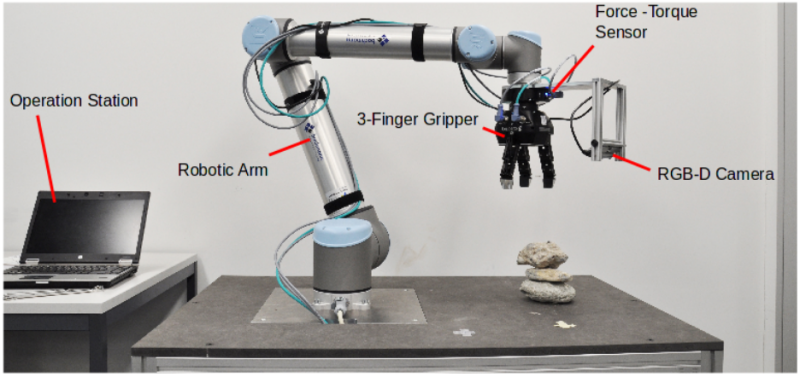June 4, 2017 weblog
Robot arm can work out how to stack stones

(Tech Xplore)—We are not surprised by now to watch the progress being made in robots doing the heavy lifting for construction sites.
The robot role in construction is getting even more interesting. Those who follow the progress in designing robots that can take on construction roles will want to check out what's going on at ETH Zurich. They have worked up a robot arm there designed to autonomously stack pieces of limestone into balanced towers. Digital Trends reported that their arm works with pieces of irregular shapes to create vertical stacks.
This is noteworthy considering what has been seen as hurdles for robots. Evan Ackerman in IEEE Spectrum called up a paradox—"building something that's easy for robots, like an exactly spaced curvy brick wall, is tricky for humans, while building something that's easy for humans, like a wall made out of pile of random rocks that doesn't spontaneously fall over, is tricky for robots."
The latter is a tough task, said Digital Trends, for a robot, due to the planning involved—"not to mention the odd shape of the irregular rocks it is being asked to manipulate."
Well, those researchers from ETH Zurich are not feeling discouraged about such difficulties. They have been working on a robot capable of working with different shapes of rocks, planning and piling them.
The team has detailed their approach in their paper, "Autonomous Robotic Stone Stacking with Online Next Best Object Target Pose Planning," by Fadri Furrer, Martin Wermelinger, Hironori Yoshida; Fabio Gramazio, Matthias Kohler, Roland Siegwart and Marco Hutter.
Four rocks are managed, as shown in a video on their work. They said in their video, "We show the results of eleven consecutive trials to form such towers autonomously using four arbitrarily placed rocks."
Ackerman, meanwhile, wrote that rock detection, physical simulation, grasping, and placement are autonomous, but there is something else to mention.
"Each rock that it can select has been 3D scanned in advance, and the system has all the information that it needs to generate a physical model that it can stack in simulation first."
The researchers used a Robotiq 3-finger gripper, FT150 force-torque sensor, Intel RealSense SR300 RGB-D camera and a UR10 arm.
Luke Dormehl in Digital Trends explaining their approach, said, "the researchers each took charge of a different operation the robot had to carry out: Either object detection, object manipulation, or a pose-searching algorithm that works out how best to stack the rocks based on what it knows about previous rock stacks."
You might wonder how long it takes the robot to complete such tasks. However, the authors said that computational and execution speed was not a focus of their paper. They did, though, include information about times. "On average, a trial to construct a vertical stack lasted 271.0 s. The main fraction of this time is spent for the manipulation task that includes path planning, arm and gripper motion. This is mainly due to the fact that the robot, for safety reasons, is operated with reduced speed."
Other time is spent for the pose searching algorithm, object detection and other tasks.
The authors said that the "stacking work-flow is not yet optimized" in terms of construction time. They said it could be improved "by parallelizing manipulation with pose searching and object detection, and by increasing the operation speed."
The researchers are also hoping to teach their system to build more complex structures—arches and walls, for example, said Ackerman. He added that they are thinking about "scaling things up, using a robotic excavator for making piles of big stones for landscaping purposes."
More information: Autonomous Robotic Stone Stacking with Online next Best Object Target Pose Planning, (PDF)
© 2017 Tech Xplore




















